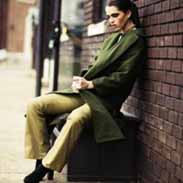Visual Anatomy & Physiology Ch 7 – Flashcards
Unlock all answers in this set
Unlock answersquestion
tibia
answer
medial leg bone
question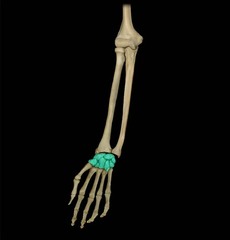
carpal bones

answer
wrist bones
question
scapula
answer
shoulder blade
question
tarsal bones
answer
ankle bones
question
sternum
answer
breastbone; flat bone forms in aterior midline of thoracic wall; has three distinct regions usually fuse together during adulthood
question
mandible
answer
lower jaw bone
question
fibula
answer
lateral leg bone
question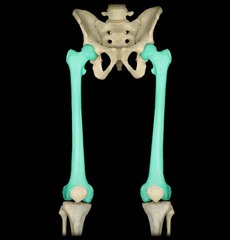
femur

answer
thigh bone
question
ulna

answer
medial forearm bone
question
clavicle
answer
collar bone
question
radius
answer
lateral forearm bone
question
humerus
answer
arm bone; extends from scapula to elbow
question
ilium
answer
superior portion of hip bone
question
squamous suture
answer
attaches temporal bone to parietal bone
question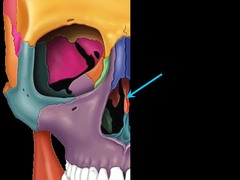
perpendicular plate of ethmoid

answer
part of ethmoid bone that forms upper bony part of nasal septum
question
occipital condyles
answer
site of articulation between skull and first vertebra of neck
question
condylar process
answer
site of articulation between mandible and temporal bone
question
lateral and medial condyles
answer
part of femur that forms joint with the tibia bone
question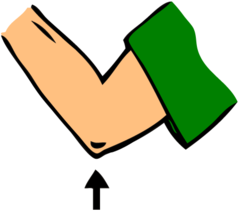
olecranon

answer
part of ulna; forms point of the elbow
question
manubrium
answer
superior portion of sternum; broad trapezoid shape; articulates with clavicles andcartilages of first pair of ribs
question
acromion
answer
part of scapula that articulates with clavicle
question
sagittal suture
answer
connects parietal bones
question
sella turcica

answer
saddle-shaped enclosure on superior surface of sphenoid bone that holds pituitary gland; means "Turkish saddle"
question
medial malleolus
answer
part of tibia that forms medial bony bump at ankle; large tibial process familiar to you sat medial projection at ankle; provides medial support for ankle joint
question
acetabulum
answer
part of hip bone that articulates with head of femur
question
lambdoid suture
answer
attaches occipital bone to parietal bones
question
coronal suture
answer
attaches frontal bone to parietal bones
question
lateral malleolus of fibula
answer
part of fibula that forms lateral bony bump at ankle; provides lateral stability to ankle joint
question
capitulum
answer
head-shaped lateral portion of the condyle of the humerus; forms lateral surface of condyle
question
xyphoid process
answer
inferior portion of sternum
question
trochlea
answer
spool-shaped medial portion of the condyle of the humerus; articulation between talus and tibia occurs across superior and medial surfaces; spool or pulley shaped articular process
question
cribiform plate

answer
part of ethmoid bone that permits passage of olfactory nerves (through olfactory foramina0; forms anteromedial floor of cranium and roof of nasal cavity
question
capitulum and trochlea
answer
part of humerus that articulates with radius and ulna
question
zygomatic arch
answer
formed from zygomatic process of temporal bone and temporal process of zygomatic bone; cheekbone
question
ischial tuberosity
answer
part of hip bone that bears body's weight when seated; roughened projection, bears body's weight when seated
question
glenoid cavity
answer
part of scapula that articulates with head of humerus; lateral angle forms a brod process that supports cup shape
question
mastoid process
answer
attachment on the temporal bone for sternocleidomastoid muscle that rotates or extends head
question
foramen magnum
answer
located in occipital bone; connects cranial cavity with vertebral canal; surrounds connection between brain and spinal cord; "big hole"
question
ethmoid bone
answer
forms roof of nasal cavity, anteromedial floor of cranium, and part of nasal septum and medial orbital wall
question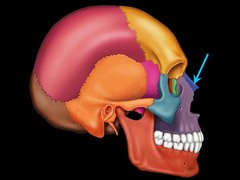
nasal bone

answer
forms superior part of bridge of nose
question
maxilla
answer
forms upper jawbone
question
body of mandible
answer
horizontal part of mandible
question
vomer
answer
forms lower bony part of nasal septum
question
fontanelles
answer
spaces between unfused cranial bones; large fibrous areas between the cranial bones
question
anterior fontanelle
answer
space between unfused bones at intersection of frontal, sagittal, and coronal sutures; soft spot on newborns; often only fontanelle easily recognized by new parents; generally persists until child is nearly 2 yrs old
question
sphenoidal fontanelle
answer
space between unfused bones between squamous and coronal sutures
question
mastoid fontanelle
answer
space between unfused bones between squamous and lambdoid suture
question
occipital fontanelle
answer
space between unfused bones between sagittal and lambdoid suture
question
bones of orbit
answer
frontal, zygomatic, maxilla, sphenoid, lacrimal, ethmoid, and palatine bones
question
auditory ossicles
answer
three bones located within each middle ear cavity (6 bones total) within the petrous part of temporal bone;
question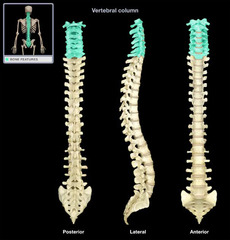
C1-C7

answer
cervical vertebrae
question
T1-T12
answer
thoracic vertebrae, articulate with ribs at costal facets
question
L1-L5
answer
lumbar vertebrae
question
S1-S5
answer
sacrum; sacral vertebrae; fused together
question
coccyx
answer
tailbone; single bone that consists of three to five coccygeal vertebrae that have generally begun fusing by age 236
question
vertebrosternal ribs
answer
ribs 1-7; also called true ribs
question
vertebrochondral ribs
answer
ribs 8-10; connected to sternum by shared costal cartilages
question
floating ribs
answer
ribs 11-12; no connection with sternum or vertebral ribs
question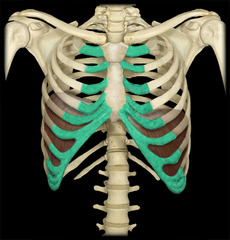
costal cartilages

answer
attach ribs to sternum; connected to sternum by individual costal cartilages
question
scapula spine
answer
posterior ridge on scapula
question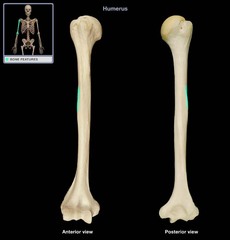
deltoid tuberosity

answer
attachment site for deltoid muscle
question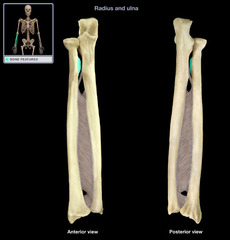
radial tuberosity

answer
attachment site for biceps brachia muscle; large surface of the arm
question
interosseous membrane
answer
fibrous sheet that connects shafts of ulna and radius and tibia and fibula; stabilize positions of tibia and fibula and provides additional surface area for muscle attachment
question
styloid process of humerus and ulna
answer
at the distal end of the radius and ulna, helps to stabilize the wrist joint
question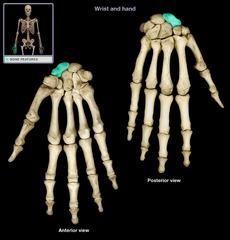
scaphoid

answer
boat shaped wrist bone; proximal carpal bone on lateral border of wrist; carpal bone closest to styloid process of radius
question
lunate
answer
moon shaped wrist bone; lies medial to scaphoid and like scaphoid articulates with radius
question
triquetrum
answer
three cornered wrist bone
question
pisiform
answer
pea shaped wrist bone; sits anterior to triquetrum
question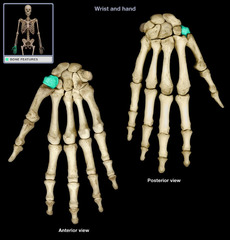
trapezium

answer
four sided wrist bone; lateral bone of distal row; proximal surface articulates with scaphoid
question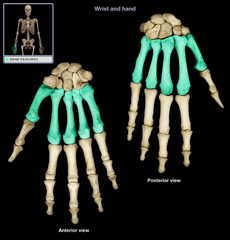
metacarpals

answer
palm bones
question
phalanges
answer
toe bones; have same anatomical organization as fingers; toes contain 14 phalanges
question
pollex
answer
thumb
question
coxal bone
answer
hip bone, three fused bones, ilium, pubis, and ischium
question
iliac crest
answer
upper ridge of hip bone; important ridge for muscle attachment
question
pubis
answer
anterior inferior portion of hip bone
question
pubic symphysis
answer
fibrous cartilage pad connecting pubic bones; right and left pubic bones attached median pad of fibrocartilage
question
ischium
answer
posterior inferior portion of hip bone
question
obturator foramen
answer
holes in ischium; space closed by sheet of collagen fibers whose inner and outer surfaces provide a firm base for attachment of muscles of hip
question
fovea capitis
answer
on head of femur bone, attachment site for ligamentum trees; small pit in center of femoral head, a ligament attaches acetabulum to femur
question
gluteal tuberosity
answer
on femur, attachment site for gluteus maximus muscle
question
patella
answer
kneecap
question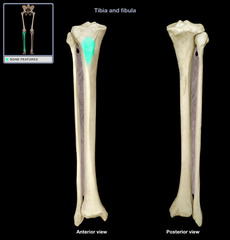
tibial tuberosity

answer
attachment site for patellar ligament
question
calcaneus
answer
heel bone, attachment site for achilles tendon; largest of tarsal bones; when standing normally most of weight is transited from tibia to talus to calcaneus and to the ground
question
talus
answer
tarsal bone one; transmits weight of body from tibia toward toes
question
navicular
answer
boat shaped ankle bone; anterior to talus, on medial side of ankle; articulates with talus and with three cuneiform bones
question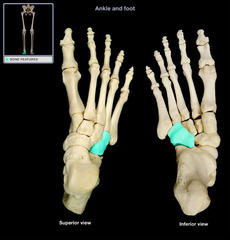
cuboid

answer
tarsal bone two; articulates with anterior surface of calcaneus
question
cuneiform
answer
wedge shaped ankle bone (3 bones)
question
hallux
answer
big toe; two phalanges, other four toes have three phalanges
question
suture
answer
immovable joint; connects bones of skull with dense fibrous connective tissue
question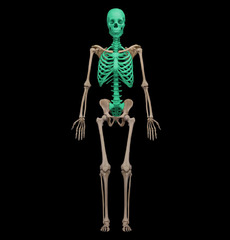
axial skeleton

answer
forms longitudinal axis of body; includes skull and associated bones, thoracic cage, vertebral column, and various supplemental cartilages; 80 bones (40% of all bones in human body); provides framework to support and protect brain, spinal cord, and organs of the trunk; joints of axial skeleton have limited movement but are very strong
question
skull
answer
22 bones of the cranium and face
question
facial bones
answer
14 bones; protect and support entrances to digestive and respiratory tracts; provide for attachment of muscles controlling facial expressions and chewing food; nasal bones (2), inferior nasal conchae (2), zygomatic bones (2), maxillary bones (2), palatine bones (2), lacrimal bones (2), vomer (1), and mandible (1)
question
cranium
answer
formed by cranial bones; enclosed the cranial cavity that cushions and supports brain
question
cranial bones
answer
8 bones; forms the cranium; occipital bone (1), parietal bones (2), frontal bones (2), temporal bones (2), sphenoid (1), ethmoid (1)
question
calvaria
answer
skullcap; comprised on occipital, parietal, and frontal bones
question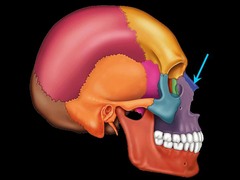
nasal bones

answer
support superior portion of bridge of nose; connected to cartilage forming distal portions of nose
question
lacrimal bones
answer
form part of medial wall of eye sockets (orbits)
question
palatine bones
answer
form posterior portion of hard palate (roof of mouth) and inferior portion of eye sockets (orbits)
question
zygomatic bones
answer
form part of the rim and lateral wall of orbits (eye sockets) and part of cheekbones
question
maxillary bones
answer
also called maxillae; support upper teeth and form inferior part of orbital rim (eye sockets), lateral parts of external nares (nostrils), upper jaw, and most of hard palate (roof of mouth)
question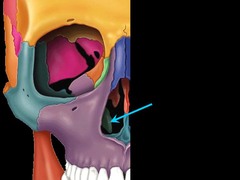
inferior nasal conchae

answer
create turbulence in air passing through nasal cavity and increase epithelial surface area to warm and humidify inhaled air
question
frontal bone
answer
forms anterior portion of cranium and roof of eye sockets (orbits)
question
sphenoid bone
answer
forms part of floor of cranium; unites cranial and facial bones; acts as a cross-brace to strengthen sides of skull
question
parietal bones
answer
one on each side of skull; form part of superior and lateral surfaces of cranium
question
occipital bone
answer
forms parts of posterior, lateral, and inferior surfaces of cranium
question
temporal bones
answer
one of each side of skull; forms past of lateral wall of cranium; articulate with facial bones; surrounds and protects inner ear structures; site for attachment of muscles to close the jaw and move the head
question
styloid process
answer
located near base of mastoid process; attached to ligaments that support the hyoid bone and to tendons of several muscles
question
external occipital crest
answer
located in center of occipital bone; site for attachment of a ligament that stabilizes the cervical vertebrae
question
superior and inferior temporal lines
answer
curved ridges that mark attachment sites of temporal is muscle (large muscle that closes mouth)
question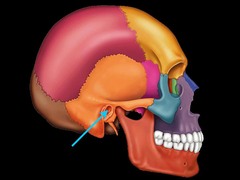
external acoustic meatus

answer
opening that leads to eardrum and middle ear; located in temporal bone
question
alveolar processes
answer
ridges that project from the maxillae and mandible to support the upper and lower teeth
question
mental protuberance
answer
attachment site for several facial muscles; located on mandible
question
zygomatic process
answer
located on temporal bone; inferior to squamous portion of temporal bone; connects with temporal process of zygomatic bone
question
frontal sinuses
answer
hollow spaces in frontal bone that vary greatly in size and time of appearance; part of paranasal sinuses
question
foramen lacerum
answer
jagged slit extending between sphenoid and petrous portion of temporal bone; passageway for small arteries supplying inner surface of cranium with blood
question
lesser wings of sphenoid
answer
extend horizontally to the sella turcica
question
greater wings of sphenoid
answer
extend laterally from body of sphenoid and form part of cranial floor; also form part of the posterior walls of the orbits (eye sockets)
question
pterygoid processes
answer
vertical projections on either side of body of sphenoid
question
sphenoid sinuses
answer
holes on either side of body of sphenoid, inferior to sella turcica
question
body of sphenoid
answer
forms central axis of sphenoid
question
zygomaticofacial foramen
answer
passageway on anterior surface of each zygomatic bone for sensory nerve that innervate cheek
question
infraorbital foramen
answer
passageway in maxilla for a sensory nerve to the face
question
nasal complex
answer
bony structure enclosing nasal cavities and paranasal sinuses; includes frontal bone, sphenoid, ethmoid, maxillae, lacrimal bones, palatine bone, and nasal bone
question
sinusitis
answer
inflammation of sinuses due to viral, bacterial, or fungal infection
question
cervical curve
answer
secondary curve of spine; develops as the infant learns to balance weight of head on cervical vertebrae
question
thoracic curve
answer
primary curve of spine; accommodates thoracic organs
question
lumbar curve
answer
secondary curve of spine; balances weight of trunk over the lower limbs
question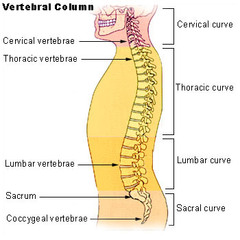
sacral curve

answer
primary curve of spine; accommodates abdominopelvic organs
question
vertebral regions
answer
regions defined by anatomical characteristics of individual vertebrae
question
articular processes of vertebra
answer
processes that extend superiorly and inferiorly from vertebra to articulate with adjacent vertebrae
question
vertebral arch
answer
forms the posterior and lateral margins of vertebral foramen
question
vertebral body
answer
part of a vertebra that transfers weight along axis of vertebral column
question
intervertebral discs
answer
bodies of adjacent vertebrae are interconnected by ligaments but are separated by pads of fibrocartilage
question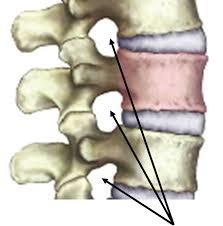
intervertebral foramina

answer
spaces formed between successive pedicles of vertebrae; passageway for nerves and blood vessels running to or from spinal cord
question
vertebral canal
answer
vertebral foramina of successive vertebrae; encloses spinal cord
question
spinous process of vertebra
answer
process that projects posteriorly from point where vertebral laminae fuse to complete vertebral arch
question
laminae of vertebra
answer
forms roof of vertebral foramen
question
transverse processes of vertebra
answer
processes that project laterally on both sides of vertebra from point where laminae join
question
pedicles
answer
form the sides or walls of vertebral arch and connect it to vertebral body
question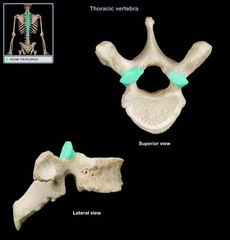
superior articular processes

answer
articulate with inferior articular processes of superior vertebra
question
inferior articular processes
answer
articulate with superior articular processes of inferior vertebra
question
costal process

answer
extends anterolaterally from either side of vertebral body
question
atlas
answer
no vertebral body and n0 spinous process, but has large, round vertebral foramen bounded by anterior and posterior arches
question
axis
answer
resembles inferior cervical vertebrae except for presence of prominent dens on superior surface of body
question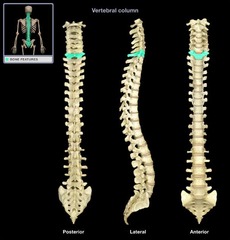
vertebra prominens

answer
prominent vertebra
question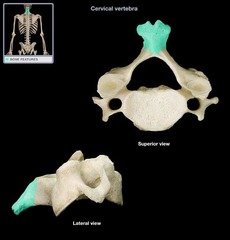
bifid

answer
typical cervical vertebra; tip of each spinous process bears prominent notch
question
spinous process
answer
projects posteriorly and inferiorly
question
ala
answer
wing; extends on either side; anterior and superior surfaces of each ala provide an extensive area for muscle attachment
question
base of sacrum
answer
broad superior surface
question
sacral promontory
answer
important surface marking in females during pelvic examinations and during labor and delivery
question
apex
answer
narrow, inferior portion of sacrum
question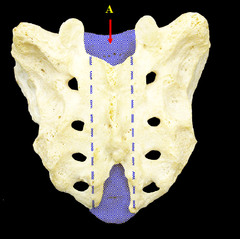
sacral canal

answer
passageway that extends length of sacrum; nerves and membranes line vertebral canal in spinal cord continue into sacral canal
question
superior articular process of sacrum
answer
articulates with last lumbar vertebra
question
sacral hiatus
answer
opening at inferior end of sacral canal
question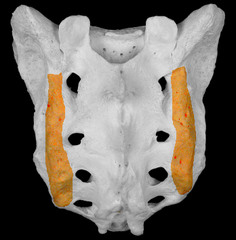
lateral sacral crest

answer
ridge represents fused transverse presses of sacral vertebrae
question
thoracic cage
answer
skeleton of the chest; provides bony support to walls of thoracic cavity; consists of thoracic vertebrae, ribs, and sternum
question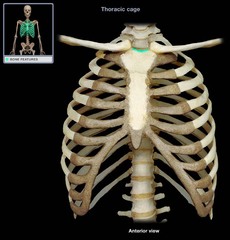
jugular notch

answer
located between clavicular articulations; shallow indentation on superior surfaceo of manubruim
question
ribs
answer
reinforce posterior and lateral walls of thoracic cavity
question
vertebral ribs
answer
attached only to vertebrae and muscles of body wall
question
body
answer
attaches to inferior surface of manubrium and extends inferiorly along midline; individaul costal cartlages from rib pairs 2-7 are attached to portion of sternum
question
xiphoid process
answer
smalles part of sternum; attached to inferior surface of body of sternum
question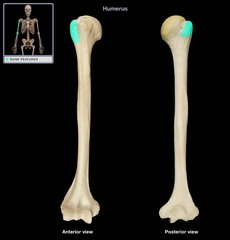
tubercle

answer
contains articular facet that contacts transverse process of thoracic vertebra
question
head
answer
also called capitulum ; there are two articular facets
question
sternoclavicular joint
answer
clavicle articulates with sternum at clavicular notch
question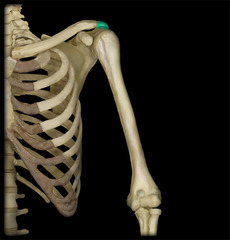
acromion

answer
stabalizes ligaments attach to conoid tubercle and costal tuberosity
question
acromioclavicular joint
answer
between acromion and clavicle
question
acromial end of clavicle
answer
broader than sternal end; has rough inferior surface that bears prominent lines and tubercles
question
lateral border
answer
axillary border
question
subscapular fossa
answer
depression in anterior surface
question
supraspinous fossa
answer
concave area superior to scapular spine
question
infraspinous fossa
answer
region inferiro to spine
question
humerus
answer
extends from scapula to elbow
question
medial and lateral epicondyles
answer
near distal articulation with bones of the forearm shaft expands to either side
question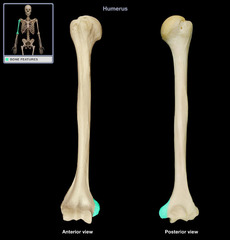
epicondyles
answer
processes that develop proximal to an articulation; provide additional surface area for muscle attachment
question
condyle
answer
humerus articulates with radius and ulna of forearm, forming tradiohumeral joint; condyle is divided into two articular regions
question
lesser tubercle
answer
smaller projection that lies on anterior, medial surface of epiphysis
question
anatomical neck
answer
marks extent of the joint capsule
question
surgical neck
answer
corresponds to metaphysics of growing bone; name reflects fact that fractures typically occur at this site
question
neck of radius
answer
extends from radial head to radial tuberosity
question
trochlear notch of ulna
answer
articulates with trochlea of humerus at elbow joint
question
radial notch
answer
smooth;l accommodates head of radius
question
distal radioulnar joint
answer
lateral surface of ulnar head articulates with distal end of radius
question
triquetrum
answer
three cornered; small pyramid shaped bone medial to lunate; articulates with articular disc that separates ulnar head form wrist
question
metacarpal
answer
articulate with distal carpal bones and support hand; identified by roman numerals beginning with lateral metacarpal bones which articulates with trapezium
question
pelvic girdle
answer
consists of paired hip bones
question
hip bones
answer
also called coxal bones or innominate bones
question
iliac spines
answer
surface markings along margin of ilium; mark attachment sites of important muscles and ligaments
question
gluteal lines
answer
mark attachment of large hip muscles
question
greater sciatic notch
answer
large sciatic nerve reaches lower limb
question
ischial spine
answer
projects superior to lesser sciatic notch, marks where blood vessels, nerves,a d small muscle pass across surface
question
lunate surface
answer
smooth, cup shaped articular surface
question
acetabulum
answer
concave socket, articulates with head of femur
question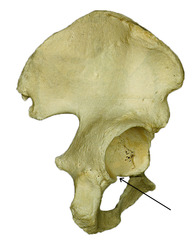
acetabular notch

answer
gap in bony rim of acetabulum
question
iliac fossa
answer
shallow depression that helps support abdominal organs and provides additional area for muscle attachment
question
arcuate line of ilium
answer
continuous with pectineal line of pubis
question
pectineal line
answer
is ridge that ends at pubic tubercle
question
pubic tubercle
answer
small elevated area anterior and lateral to pubic symphysis
question
iliac tuberosity
answer
roughened area superior to auricular surface; ligaments originating here stabilize sacroiliac joint
question
sacroilic joint
answer
articulation between sacrum and adjacent ilium, supported by extensive network of ligaments; joints form union between axial skeleton and appendicular skeleton
question
pubic symphysis
answer
fibrocartilage pad that forms articulation between two pubic bones
question
pelvic brim
answer
bony margin of true pelvis
question
pelvic inlet
answer
opening enclosed by pelvic brim
question
pelvic outlet
answer
opening bounded by coccyx, ischial tuberosities and ischial spines, and inferior border of pubic symphysis
question
femur

answer
thigh
question
greater trochanter
answer
large rough projection that extends laterally form junction of head and shaft
question
femoral head
answer
articulates with pelvis at acetabulum
question
inertrochanteric line
answer
marks edge of articular capsule on anterior surface of femur
question
lesser trochanter
answer
projects posteriorly and medially form junction of head and shaft
question
adductor tubercle at end of medial supracondylar ridge
answer
marks attachement site of adductor magnus muscle
question
gluteal tuberosity
answer
marks attachment of gluteus maximus muscle
question
linea aspera
answer
rough ridge that marks attachment site of powerful hip muscles
question
popliteal surface

answer
flattened triangular area
question
patellar surface
answer
smooth articular surface over which patella glides
question
base of patella
answer
attachment area for quadriceps tendon
question
head of fibula
answer
articulates with tibia; articular facet is located on anterior inferior surface of lateral tibial condyle
question
anterior margin
answer
ridge that begins at tibial tuberosity and extends distally along anterior tibial surface
question
lateral facet
answer
lateral condyle of femur
question
medial facet
answer
for medial condyle of femur
question
intercondylar eminence
answer
ridge that separates condyles
question
cuneiform bones

answer
arranged in row with articulations between them; named according to relative positions, medial, intermediate, and lateral
question
metatarsal bones of foot
answer
five long metatarsal bones form distal portion of foot
question
calcaneal tendon
answer
posterior portion of calcaneus is rough, knob shaped projection; arises at calf muscles
question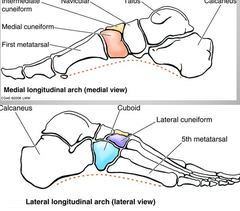
longitudinal arch of the foot

answer
amount of weight transferred forward depends on position of foot and placement of ones body weight
question
dancer's fracture
answer
diaphysis of fifth metatarsal is broken
question
transverse arch
answer
degree of longitudinal curvature changes from medial border to lateral border of foot

